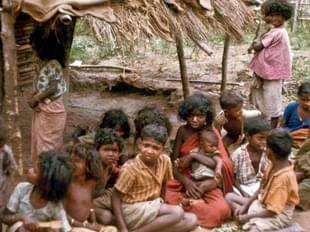Politics
The Starving Tribals Of Kerala’s Attappady: A Shocking Case Of Government Apathy
Swarajya Staff
Feb 26, 2018, 02:18 PM | Updated 02:18 PM IST
Save & read from anywhere!
Bookmark stories for easy access on any device or the Swarajya app.


Attappady is a tribal belt in Kerala’s Palakkad district, where starvation is claiming lives – a blot on the human development record the state takes pride in.
It is also the region where a hungry, mentally-challenged tribal man was driven to stealing food and had to pay with his life. Thirty-year-old Madhu of Attappady’s Kurumba tribal community was lynched to death last week by a mob for stealing food provisions from a store.
Malnutrition, birth defects and poor maternal health continue to afflict the tribals, with a recent report in The Hindu, putting infant death toll at 14 in the last year. The report said, in 2016, eight children died of birth defects in the region.
Despite initiatives to supply nutritious meals through community kitchens, 672 tribal children in the region are suffering from malnutrition. Of this, 370 children had been found acutely malnourished, needing urgent attention, said the report. This has shifted the focus to the role of community kitchens and their operations.
Attappady is a tribal block established in 1962 and located east of the Silent Valley in the Western Ghats, one of the world’s most famous biodiversity hotspots. Yet the tribal community, there, are victims of state apathy.
In 1951, Attappady’s tribal population stood at 90.26 per cent, and which in 2011 has fallen to 34 per cent, the report said.
A 2014 report titled ‘A Tragedy Unfolding’ in the Economic and Political Weekly (EPW) cites UNICEF statistics (2013) that ascertained a total of 39 deaths had been reported from Attappady tribal block between April 2012 and May 2013. The major causes of death, it said, included acute breathing disorders, preterm and low birth weight, development growth delay, and intrauterine growth retardation (poor growth of the foetus).
The EPW report substantiates an alarming rate of child mortality among the tribal community, despite the existence of social security and welfare schemes, and laws in the interests of the tribals like the Forest Right Act and Restriction of Transfer of Land and Restoration of Alienated Land Act.
The report cites C D Rozario (2013) who observed that 36 children had died between January 2012 and April 2013 compared with 25 and 32 starvation deaths in 1996 and 1999 respectively.
A Times of India report in 2013 revealed a more shocking estimate of “58 malnutrition deaths in the past 20 months” in Attappady tribal block.
The Ekbal Committee Report (2013) said that in 2013 about 30 children died within a few hours or days of their birth. A team of experts from the National Institute of Nutrition (2013) visited Attappady tribal area for studying infants or children deaths and reported that the infant mortality rate (IMR) there was 66 as compared to 14.1 deaths per 1000 live births in the rest of the state.
This is further substantiated by a survey conducted by Thampu, a non-governmental organisation (NGO) dealing with tribal rights. It said out of the 300 tribals affected by malnutrition 200 were children.
A government’s step-motherly treatment towards its tribals and marginalised sections of the society is evident in the poor health, literacy and nutritional records in the tribal districts as compared to the rest of the state.
Kerala boasts robust performance in the health sector but malnourishment and health problems are found to be high among tribal groups, fisher folk and related communities in the state. Rozario has observed that among adivasi children of 12 months or less, 9.1 per cent are severely underweight, 32.2 per cent suffer from severe stunting and 7 per cent suffer from severe wasting. Besides, it was found that 54 per cent of children from the fisher folk community below the age of six were malnourished.
There is a stark difference in literacy rates among tribals as compared to the rest of the state: While tribal males and females is 64 per cent and 56 per cent respectively, male and female literacy rates in the rest of Kerala stand at 96 per cent and 92 per cent respectively (Census 2011).
Attappady can be called Kerala’s “sub-Saharan Africa” said the Ekbal Committee (2013) observing that most women had undergone abortion more than once and almost all children examined suffered from anaemia and malnutrition.
The difference between the nutritional status of Kerala’s general rural population and that of Attappady could be as high as 50 per cent.
The several reasons for the poverty and abysmal health conditions among the tribal community lie in the loss of land, traditional shifting cultivation, and loss of traditional food items such as ragi, chama, cholam, veraku, thina, thuvara, honey, tubes, roots, medicinal vegetables.
Add to this, the failure of public distribution system; poor performance of Mahatma Gandhi National Rural Employment Guarantee Scheme (MGNREGS); a lack of essential drug supplies such as Mesoprestol and Magsulf for delivery and childbirth related medical emergencies; disempowerment of the adivasi communities; failure of Attappady Hill Area Development Society (AHADS), a Japanese funded project, aimed at ensuring a sustainable livelihood and ecology; and delays and inefficiency in executing the laws and projects.
The EPW report suggests that the tribals’ livelihood opportunities can be increased by re-establishing their rights over property, and by increasing their access to health, security and education.
Madhu’s death could be a one-off incident but a pointer to the harsh reality of deaths due to starvation that still prevails in Attappady, the only tribal block in the state, and yet, neglected by the state government.





